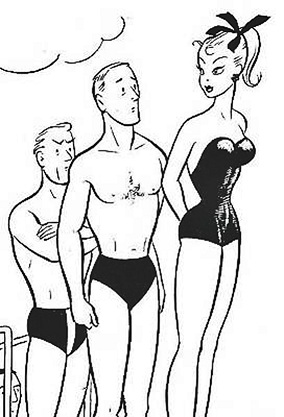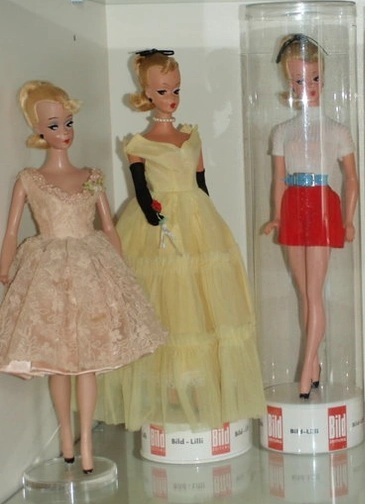Bild Lilli Doll
Bild Lilli Doll was a German fashion doll produced from 1955 to 1964. She is the predecessor of the most famous doll in the world: Barbie.
 Ordered to draw a "filler" caricature of the comic strip, for the inaugural edition of the German tabloid newspaper Bild,
From June 24, 1952, Reinhard Beuthien drew a rebellious baby; His editor didn't like it, so he adapted the drawing to a sexy blonde
with a ponytail sitting in a fortune teller's shop where Lilli asked:
Ordered to draw a "filler" caricature of the comic strip, for the inaugural edition of the German tabloid newspaper Bild,
From June 24, 1952, Reinhard Beuthien drew a rebellious baby; His editor didn't like it, so he adapted the drawing to a sexy blonde
with a ponytail sitting in a fortune teller's shop where Lilli asked:
- "Can't you give me the name and address of this tall, handsome and rich man?"
The cartoon was an immediate success and became a daily Bild feature.
Lilli was a post-war character, daring and ambitious, a curvy and provocative woman who was always available for men, "a money seeker, exhibitionist and quick-witted girl (whore, easy-going...)". She gave life to a crazy modern, independent and sophisticated girl, who worked as a secretary, enjoying the life and protection of numerous gentlemen, almost always of mature age and with a lot of money.
The cartoon always consisted of an image of Lilli speaking, dressed or undressed in a way that showed her figure, usually to friends, boyfriends or her boss.
She had funny or sensual dialogues. Sometimes Beuthien's cartoons also included sexual themes.
To a police officer who told her that two-piece swimsuits are prohibited on the street, she replied
- "Oh, and in your opinion, which part should I remove?"
- Of course I am interested in politics. No one should ignore the way some politicians dress!
- The sunrise is so beautiful that I always stay late at the nightclub to see it!
At first, Lilli was a cartoon character, created by Reinhard Beuthien for the German tabloid Bild-Zeitung in Hamburg, Germany with great diffusion in Germany, Switzerland and Austria.
In 1953 the Bild-Zeitung decided to market the Lilli doll and contacted Max Weissbrodt of the Hausser toy company in Neustadt/Coburg, Germany.
The Bild Lilli doll was a German fashion doll released on August 12, 1955 and produced until 1964. The doll came in two sizes and had a closet of 1950s fashion available.
Following Beuthien's drawings, Weissbrodt designed the doll prototype and was sold from 1955 to 1964, when Mattel acquired the rights to the doll. so the German productions had to stop. Until then, 130,000 units had been reached.
Today Lilli is a collector's item just like Barbie and has great economic value.
 Bild Lilli was made of polystyrene, 2 sizes available:
Bild Lilli was made of polystyrene, 2 sizes available:
- 30 cm (12 inches)
- 19 cm (7.5 inches)
He had three absolutely new patents in the manufacture of dolls:
- The head and neck were not a shape connected with a seam at the shoulders, but rather the seam was in the middle of the neck, behind the chin.
- The hair was not rooted, but had a clipped scalp (wig) that was held in place by a hidden metal screw. She could be blonde or brunette.
- Her legs did not open when she was sitting.
The doll was made of polystyrene plastic and had the following characteristics:
- Molded eyelashes.
- Pale skin.
- Face painted with very marked makeup.
- Eyes painted with blue shadow and black eye-liner. Her eyes had a sideways look.
- High and narrow eyebrows.
- Red lips in the shape of a heart.
- Her nails were also painted red.
- She wore her hair in a ponytail with a curl kissing her forehead.
- His shoes and her earrings were molded.
- Its limbs were joined on the inside with coated rubber bands.
The cartoon Lilli was blonde, but some of her dolls had other hair colors.
Each Lilli doll carried a miniature copy of Bild and was sold in a clear plastic tube, with the doll's feet wedged into the base of a stand labeled "Bild-Lilli" that formed the bottom of the tube; The packaging was designed by E. Martha Maar, the mother-in-law of the Hausser company owner.
Originally, tall dolls (30cm) cost DM 12, small dolls (19cm) DM 7.50 at a time when the average monthly payment to take home was 200 DM to 400 DM.
As this price suggests and because of how outrageous Beuthien's cartoons were, Bild Lilli dolls were sold as joke toys for adults, mainly men, as many parents did not consider them appropriate for children. For example, they were given as gifts at bachelor parties, gifts at tobacconists, kiosks and kiosks that typically sell flowers, chocolates and other small gift items. It was also common to hang a Lilli doll on the rearview mirror of the car, in fact it had a swing that was attached to the rear window and where she could sit.
A German brochure from the 1950s claims that Lilli was "always discreet", and that her wardrobe made her "the star of every bar", and an advertisement from the 1960s encouraged young men to give their girlfriends a Lilli doll as a gift, instead of flowers. (This last ad was referenced by a cartoon in the Lilli newspaper, where Lilli says to her boyfriend: "I thought it was so appropriate that you gave me a Lilli doll, now I have a similar gift for you" as she presented him with a puppet).
A total of 130,000 were made. The doll also became popular among girls. The doll houses, the details of the rooms, furniture and other toy accessories scaled with little Lilli were produced by German toy factories to take advantage its popularity among children and parents.
Lilli came as a dressed doll - additional fashions were sold separately.
She had a very curvy adult body and was sold dressed in a rich and varied wardrobe with more than 100 creations mostly designed by M.E. maar, Beuthier's woman, reflect the lifestyle of the 1950s. She had different models, such as:
- Outfit to go to parties
- Beach outfit
- Tennis suit
- Cotton dresses for morning, afternoon and evening
- Pajamas
- Poplin suits
In her later years, her wardrobe consisted mainly of traditional "dirndl" dresses. Dirndl is the name of a traditional female dress used in Austria, South Tyrol and Bavaria. It is based on the traditional clothing of the Alpine peasants.
Lilli's dresses always have patent closures marked "PRYM". PRYM is the oldest family business in Germany, with more than 12 generations, They are dedicated to manufacturing and marketing semi-finished copper and brass products, as well as haberdashery items.
It was sold packaged in a transparent cylinder, with a base that was inserted into some holes in its feet and a miniature of the Bild newspaper.
Lilli did not have a boyfriend or friends, but she did have a poodle dog, which she would later also give life to Barbie's first pet.
Lilli and her fashions were sold as girls' toys in several European countries, including Italy and the Scandinavian countries; outside Germany, She is generally remembered as a girl's doll.
In the United States, she was called "Lilli." Some Lillis have been seen in the original 1950s packaging for an English-speaking market called "Lili Marleen", after the famous song.
It was a doll that was initially very successful and several toy companies made numerous clones of it, dolls that resemble Bild Lilli, some from original molds purchased, both in the US and in Europe and the East (HONG-KONG LILLIES).
Also in Spain, Muñecas FEJ (Guillén and Vicedo) copied the molds and made a very similar doll, possibly called Paula, but with darker skin, white earrings and articulated waist. However, Spanish society was extremely conservative then and was not ready for such "sexy" dolls. Mothers did not buy them for their daughters and the manufacturer had to withdraw them from the market.
The Mattel Barbie doll, which appeared in March 1959, was based on the Bild Lilli dolls that co-founder Ruth Handler had acquired in Hamburg. Barbie was made of softer plastic, wore less makeup, had paler skin and the doll had rooted hair with non-molded shoes and earrings, other than that she was similar to Lilli.
Louis Marx and Company acquired the rights to Hausser's Bild Lilli doll and sold the smaller Miss Seventeen and Miss Marlene dolls.
In 1963, Handler's company Mattel bought the rights to the Bild Lilli doll, stopping its production in Germany.
It must be taken into account that adult mannequin dolls have been sold for play in the United States since 1955/56, like Cissy by Madame Alexander or Revlon dolls by Ideal.
In 1958 a film about Lilli was released in Germany:
Lilli - ein Mädchen aus der Großstadt - (Lilli, a girl from the big city), a comedy-mystery directed by Hermann Leitner.
A contest was held to choose the star; The winner was the Danish actress Ann Smyrner.
In 1962, Beuthien created another cartoon character called "Schwabinchen" for a Bavarian newspaper,
but she was not as successful as Lilli and the dolls inspired by her were of poor quality.
She later started "Gigi", which was even less successful and never became a doll.
There are no books about the Lilli doll as such. Unlike Barbie, she was only produced for eight years and
It never reached the importance of the American doll. But books about Barbie do appear.
Lilli also appears in books where they talk about the German lifestyle in the 50s, there are chapters dedicated to Lilli.
For example, in Knaak's book all the dolls and their wardrobes are described with color images.
